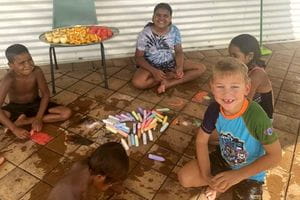Fitzroy kids enjoy Swim for Fruit fun
 Fitzroy Crossing is a small town in our state’s Kimberley region, 400 kilometres east of Broome. It sits on a low rise surrounded by the vast floodplains of the Fitzroy River and its tributary Margaret River, meaning that playing in the local waterways is a very popular pastime for the children and families living in the area.
Fitzroy Crossing is a small town in our state’s Kimberley region, 400 kilometres east of Broome. It sits on a low rise surrounded by the vast floodplains of the Fitzroy River and its tributary Margaret River, meaning that playing in the local waterways is a very popular pastime for the children and families living in the area.
The Fitzroy Crossing townsite is surrounded by around 50 Aboriginal communities scattered throughout the Fitzroy Valley, with around 80% of the population in the region Aboriginal Australians. The Fitzroy Crossing Remote Aboriginal Swimming Pool was among the first to be set up as part of our Remote Aboriginal Swimming Pool program more than 20 years ago.
Recently the pool saw two new managers move into town, with Chris Osborne and Katie Boland taking the reigns following the departure of long-time managers Trevor and Adele Caporn. They’ve enjoyed a fantastic, but very wet first season at the pool, but despite the rain the local children keep turning up to enjoy fun, swimming lessons and the challenge of the Go for 2&5 Swim for Fruit program.
Swim for Fruit is an initiative supported by Healthway and facilitated by the Royal Life Saving WA, which aims to improve the overall health status of Aboriginal children in regional and remote communities. It was developed more than a decade ago to improve water safety, physical activity, and adequate fruit and vegetable intake amongst the young Aboriginal and non-Aboriginal community. Research shows that most Aboriginal children do not consume adequate daily fruit and vegetables, with data showing that 85% of Aboriginal children were not meeting recommended intake of fruit and vegetables.
Fitzroy Crossing pool manager, Katie Boland says the program has been a big hit this season. “The kids absolutely love the swim for fruit program. Last Saturday we had a drawing competition to brighten up the pool which saw each child enjoy fresh fruit whilst using chalk to draw native animals and plants on the concrete."
We’re excited to see the children’s engagement with the program and the way they enjoy spending time at their local pool. You can read more about our Remote Aboriginal Swimming Pool program and its work across regional WA at the link below.
